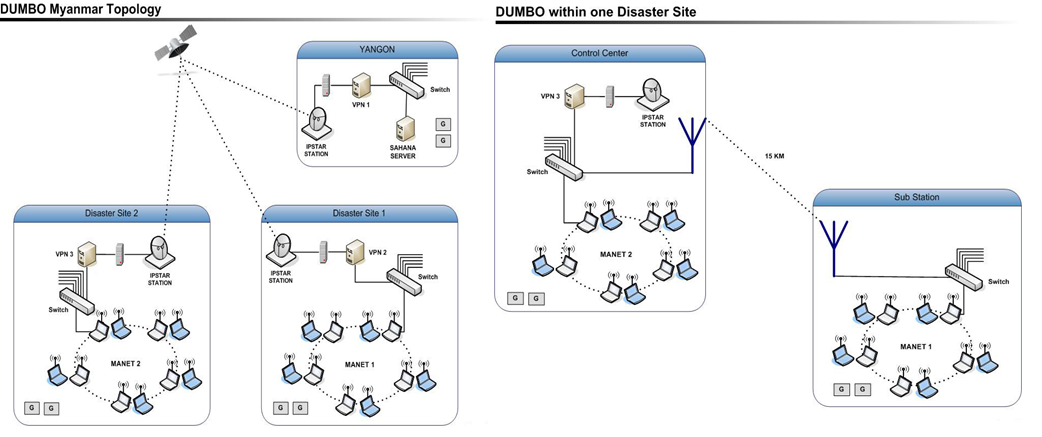A deadly tropical cyclone Nargis, which occurred over the Bay of Bengal, hit Myanmar on May 02, 2008. It devastated five divisions and states - Yangon, Bago, Ayeyarwaddy, Kayin and Mon. Ayeyarwaddy and Yangon sustained the heaviest casualties and infrastructural damages. Affected coastal towns in the southwestern Ayeyarwaddy division include Haing Gyi Island, Pathein, Myaungmya, Laputta, Mawlamyinegyun, Kyaiklat, Phyar Pon, Bogalay etc.
The next day of the disaster, the Myanmar government declared five divisions and states as natural-disaster-hit regions a day after the cyclone hit the country. According to official figures, 84,500 people were killed and 53,800 went missing. A total of 37 townships were significantly affected by the cyclone.

As part of AIT''s Response to the Myanmar Cyclone Disaster, the Internet Education and Research Laboratory (intERLab) provided DUMBOs aiming to assist for better coordination among field workers of local government agencies and NGOs. The support was possible due to the help of Internet organizations in Asia Pacific region, such as APNIC, APNG, DotAsia, Relief.Asia, SOI-Asia, WIDE Project, THNIC etc., intERLab provided support to the communities. IntERLab's supports consisted of two phase:
Training to Myanmar's Engineers and DUMBO's support :
As a first phase of support, DUMBO introduction and deployment training was held from 21-25 May, 2008 at IntERLab. Five engineers from 'Myanmar Egress' ( local partner organization) were participated in the week long training. The training gave them opportunities to interact with DUMBO and its environment, and at the same time it also enhances their confidence to deploy the supported equipments in the disaster hit sites.

The expected task of the trained engineers were as follows:
- Inspection of disaster sites
- Necessary hiring and training of staffs/ volunteers
- Presentation to other local stakeholders and obtain their cooperation
- Opening of teams office in affected areas
- Base data collection and input
- Software, hardware, and network deployment
- Hosting of server
- Customize/ extend applications on the provided infrastructure
- Set up Command/Control center at remote sites
As a key support of the first phase, we provided the following equipments to deploy in the affected areas:
- IPStar satellite stations & connection (With permission to use existing IPStar connection in Yangon) (3 Units)
- VPN Server (Desktop PC) (3 Units)
- Wireless Switch Access Points (6 Units)
- EeePC ASUS 8G w/ Build-in Webcam (30 Units)
- Point-2-Point Wireless Antenna (9 Units)
- Omni Directional Antenna (15 Units)
- Microclient w/1GB Memory (60 Units)
- Portable Power Generators (6 Units)
- Battery + Invertors (6 Units)
- Network cables and computer appliances
- PC for Sahana (Missing Persons Database System) Linux Server (1 Unit)
- AS MANY INTERNET TABLETS (NOKIA) and as many laptops as possible

Deployment at the affectes Sites:

Phase II - Utilization of MANET networks in disaster areas by government agencies and local NGOs.
Our idea was to turn the ordinary computers such as laptops and PDAs, to network devices without having to acquire special hardware. Any guest computer, with simple software installation and configuration, can join in and be a part of the DUMBO network. On this network, we installed EasyDC software for emergency communications which enables VOIP and short messages applications.
Local partners :
Myanmar Egress, a non-profit Organization founded by Myanmar scholars and social workers who have been actively engaged in philanthropic activities in Myanmar in the last fifteen years were our local partners for the deployment of DUMBOs system. It maintains close links with the business community in the country and strives to facilitate “public-private partnerships” and facilitate the linkage between public needs and private resources. Due to its close cooperation with the local business community and the development sector, Myanmar Egress and its partners have the capacity to mobilize large number of volunteers and resources within Myanmar. Hence while the organization is based in Yangon, its wide networks allow them to work in any other regions of the country at any time. Myanmar Egress has been authorised by the Myanmar government to perform the rescue work. Myanmar Egress’ ties with the local business community and the development sector enables it to provide assistance to the affected areas quickly, by reaching out to and tapping on their partners’ logistics and infrastructural resources as well as existing networks.
Key lessons :
- Localization
- Beneficiaries database
- location database
- Open use of necessary frequencies - government restrictions
- Weather vulnerability (during heavy monsoon, most of common use ICT equipments can not be deployed outdoor)
- Battery life
- Bandwidth limitation
- Video option is unreliable
- Difficult transportation in low-line delta area
- Shortage of regular power supply
- Difficult to maintain regular ICT equipments in the harsh field operation
Useful Links and News:
- AIT's response to Myanmar Cyclone Disaster: www.ait.ac.th/news-and-events/ait-response-to-myanmar-cyclone-disaster#.V2-lM7h97IU
- IntERLab at AIT Responding to Myanmar Cyclone Disaster: www.ait.ac.th/news-and-events/2008/news-1/interlab-aits-responding-to-myanmar-cyclone-disaster#.V2-lFLh97IU
- Introducing DUMBO's in Myanmar: www.google.co.th/url
- Press release by Myanmar Egress: www.interlab.ait.ac.th/myanmar/cyclone/resources/Report-Myanmar-Egress.pdf
- Myanmar Cyclone 2008: www.interlab.ait.ac.th/myanmar/cyclone/



